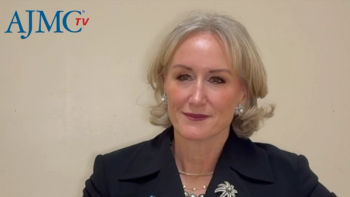
New Insights Into Meth-Associated PAH Care Gaps: Anjali Vaidya, MD, on Closing the Divide
Research from Anjali Vaidya, MD, FACC, FASE, FACP, Temple University Hospital, reveals critical care gaps for patients with methamphetamine-associated pulmonary arterial hypertension (PAH), emphasizing the need for early diagnosis and integrated support.
At the 2025
Vaidya and her team explored the clinical experiences and care gaps faced by this vulnerable population, highlighting critical issues such as delayed diagnosis, lack of toxicology screening, insufficient patient education, and the impact of stigma on clinical encounters. Many patients also reported barriers including limited access to PAH specialists, mental health support, and substance use treatment.
The findings underscore the need for earlier recognition and more empathetic, multidisciplinary care. Importantly, satisfaction was highest among patients who received care from PAH-specific teams that fostered trust and ongoing communication.
Vaidya, who is also a professor of medicine and an advanced heart failure and transplant cardiologist who has spent the past 15 years focusing on all forms of pulmonary hypertension (PH), emphasizes that routine methamphetamine screening, better physician education, and integration with addiction care are essential steps toward improving outcomes. This work sheds light on the unique challenges of meth-PAH and calls on both clinicians and health care systems to expand awareness, reduce stigma, and invest in more tailored care strategies.
This transcript has been lightly edited for clarity.
AJMC: What inspired this study, and how did you approach your target population?
VAIDYA: This study involved interviews with patients in the US who have been diagnosed with and treated for meth-APAH. It was inspired by the growing rate of methamphetamine use across the country. Previously, use was thought to be more concentrated in the southwestern region of the US. However, in recent years, methamphetamine use has been recognized—especially in the PAH field—as rapidly spreading across the nation. Methamphetamine is a known cause of severe PAH, but it remains relatively underrecognized and treated around the world. That’s why we felt inspired to research this vulnerable and growing patient population.
AJMC: What were some of the most important findings from your study—both expected and unexpected?
VAIDYA: Although the majority of patients were still using methamphetamine at the time of their PAH diagnosis, only half were asked about the details of their use by the treating physician—and most were not asked to undergo a toxicology screen. Further, prior to diagnosis, 70% of patients experienced a missed diagnosis, and nearly half of patients felt they did not receive adequate education about their disease. Not surprisingly, patients were most satisfied when under the care of PAH specialists—especially when they felt a positive relationship with their PAH care team.
AJMC: How does methamphetamine-associated PAH differ from other types of PAH when it comes to symptoms, progression, and treatment needs?
VAIDYA: The symptoms and clinical presentation can be very similar to other forms of PAH. However, the biologic effects of methamphetamine use on pulmonary circulation can be distinct. Treatment must address not only the cardiopulmonary effects of PAH but also methamphetamine use itself.
AJMC: How do social factors—like insurance barriers or limited access to mental health care—affect outcomes for patients with meth-APAH?
VAIDYA: Patients often come up against limitations in their care, including insurance hurdles, the burden of having to travel to see physicians with PAH expertise, and excessive wait times for appointments with PAH specialists.
AJMC: Does the age when patients begin using methamphetamine—or how they use it—have an impact on disease progression or severity?
VAIDYA: Half of the patients began using methamphetamine between the ages of 18 and 25 years. A quarter started even before age 18 years, and the rest between the ages of 25 and 49 years. Most patients used inhalation, but 40% of patients reported ingestion, injection, or a combination of routes. Similar to other patients with PAH, most of these individuals required combination medical therapy for PAH treatment with either 2 or 3 medications.
AJMC: What are the main challenges clinicians face in identifying methamphetamine use, and how can they approach these conversations without reinforcing stigma?
VAIDYA: Clinicians face barriers such as lack of awareness and education about methamphetamine use. Overcoming stigma or moving away from stereotypes is critical. We need to recognize that people from all walks of life can be affected by methamphetamine use.
AJMC: Since stigma often delays diagnosis, what strategies do you recommend to improve early detection of meth-APAH?
VAIDYA: Education for physicians who are likely to be the first point of contact for these patients—such as those in emergency medicine, primary care, hospital medicine, cardiology, and pulmonary specialties—is essential. Integrating routine history taking and laboratory screening for methamphetamine use during initial evaluation for pulmonary hypertension (PH) is also recommended to help improve early detection of Meth-APAH.
AJMC: What kinds of educational or clinical support do patients with meth-APAH need most?
VAIDYA: Patients need accessible, clear information about PAH—including what to expect in terms of testing, treatments, and long-term monitoring. They would also benefit from integrated care with substance abuse specialists who can help support their recovery and health more broadly.
AJMC: How does involving addiction specialists and other disciplines improve outcomes for patients who have meth-APAH?
VAIDYA: It is essential for PH specialists to work close with substance abuse specialists to provide truly comprehensive, supportive, and adequate care for these patients.
AJMC: What do you see as the most urgent next steps—either in research or clinical care—to close gaps in meth-APAH care?
VAIDYA: The most urgent next steps include increasing awareness among specialists who diagnose PAH so they can make timely diagnoses and initiate appropriate treatment—including what to expect over time and risk assessment over years. We also need to expand access to substance abuse care and strengthen education for patients around PAH management.
This study is the first of its kind to highlight experiences faced by patients with meth-APAH and the urgent need for increased empathy, awareness, educational resources, and collaboration with substance abuse specialists.
Newsletter
Stay ahead of policy, cost, and value—subscribe to AJMC for expert insights at the intersection of clinical care and health economics.












































